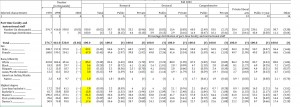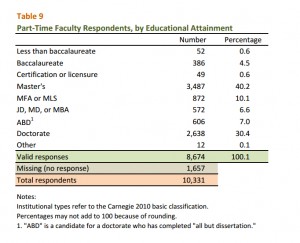$15,000 per class.
That is the rallying cry of the adjunct activist movement as espoused by the SEIU and its “Faculty Forward” campaign. The figure derives from its parallels with the $15/hour minimum wage political campaign, although it has roots in another favorite adjunct activist fallacy: the Labor Theory of Value. According to this theory, adjuncts should be paid by the value they supposedly “create” in the classroom. Adjunct advocacy pieces are therefore littered with rudimentary Labor Theory of Value calculations by persons who lack a basic understanding of labor economics. These armchair attempts at economic astrology usually assert that the typical college class is “worth” about $30,000 to the university. Allowing for a generous overhead – or so they reason – would yield a remainder of $15,000 per class for the instructor, or five times the current adjunct going rate of about $3,000 per class.
Proponents of this solution seldom consider its effects on adjunct employment, including their own present employment status. But let’s run a quick thought experiment to see what would happen if, by chance, they got their way. Suppose a $15,000 per class minimum was either voluntarily adopted by universities in the name of “social justice” or enacted by law. Suppose for the purposes of this experiment that budget constraints are not an issue and this new compensation level could be sustained, whether by reallocating money from administrative overhead or making additional public investments in our university system. Also assume that the number of courses offered remained unchanged. What would happen next?
If compensation per course jumped from $3,000 to $15,000, there would likely be an influx of new applicants for adjunct positions. Many of these applicants would be highly qualified PhD-holding professionals with strong research records who currently work in other sectors of the academy or economy. Some might be highly skilled professionals who currently teach part time on the side for a little extra income, or because they enjoy doing so. Others would be newly minted PhDs who have promising research agendas, but are also having trouble finding a tenure track position in the saturated job markets of their fields.
In fact, at $15,000 per course a well-qualified PhD holding adjunct could potentially become very wealthy. A normal “full time” 4-4 courseload split between just two universities would yield a qualified adjunct $60,000 a semester, or $120,000 a year. Additional summer teaching could bump that up further by $30-60K. And keep in mind that these positions, being adjunct, come with no obligations to perform department or university service work.
If this sounds appealing, it is…for the person who lands the adjuncting job. But that’s where our thought experiment begins to run into trouble. You may recall from my previous essays on the subject that the current adjunct employment pool is dominated by faculty who lack a terminal degree in their respective fields. U.S. Department of Education statistics bear this out as well – the typical adjunct in the United States has only a Master’s degree or less:
(Yes, I’m well aware that the Dept. of Education chart is a decade old. It’s the most recent one they’ve published. So if you think this trend is out of date, you may see in the figure below that its findings are nearly identical to the 2012 Coalition on the Academic Workforce survey. Several other studies have affirmed the exact same thing)
So what does this mean in light of our experiment? If adjunct wages were increased to $15,000 per class, there would be a sharp influx of applicants who are significantly more qualified than the current pool of adjuncts, most of whom only have a Master’s degree or less. While many of those new PhD-holding, well published, and highly credentialed applicants could make a very healthy living from teaching alone at $15,000 a course, the less-qualified current adjuncts with non-terminal degrees and weaker CVs would find it significantly harder to obtain work. For a great many of these adjuncts, their salaries would quickly drop from $3,000 per class to $0 as they found themselves unemployed and unemployable when competing against new applicants who have better qualifications than their own.
Of course this all presumes that our university system could even afford to pay $15,000 a class, which it plainly cannot. The budgets simply don’t work out, even if we could figure out a way to completely eliminate the related and very real problem of administrative bloat (and all of its expensive junk ideological causes, masquerading as core university functions). Considering that full tenured professors with 4-4 teaching loads make less than this proposed equivalent, and considering the strains of current university budgets, this proposition is nothing short of insanity (even if a case could be made for more modest payscale differentiation in the adjuncting world). To those advancing the $15,000 proposal though, it’s far from the benefit they imagine and almost a certain guarantee that they would be out of an academic job entirely.
Adjunct activists: be careful of what you wish for.

